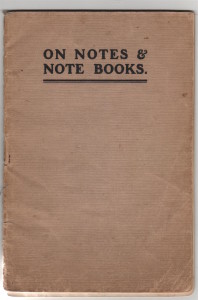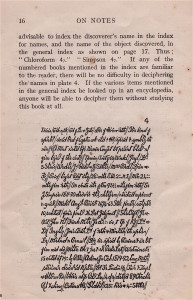 Now we are in the Digital Age, when as much data as we like can be stored in a note-book sized device made of plastic and metal, note-taking as a aid to memory is less important. As recent as fifteen years ago if we needed to record the gist of books, articles etc., we resorted to a note book made of paper and card which had to be small enough to be carried around in a pocket. In practice what we tended to do, however, was to write too much in too big a hand than was appropriate, thus making our notebook less efficient as a means of storing an accumulation of facts and opinions.
Now we are in the Digital Age, when as much data as we like can be stored in a note-book sized device made of plastic and metal, note-taking as a aid to memory is less important. As recent as fifteen years ago if we needed to record the gist of books, articles etc., we resorted to a note book made of paper and card which had to be small enough to be carried around in a pocket. In practice what we tended to do, however, was to write too much in too big a hand than was appropriate, thus making our notebook less efficient as a means of storing an accumulation of facts and opinions.
The solution, according to a self-published booklet of c 1934 entitled On Notes and Note Books by someone called David B. Muir of Dresden Road, Holloway, north London, was to accommodate more notes on literary material that interested us by reducing our hand to the size of newsprint, abbreviating words and compiling an index.
In Muir’s system of abbreviations a series of short straight or curved strokes above the missing letters, dots above and below, and other symbols for prefixes, would indicate the types of contractions intended. Discrete items of information would be separated by double or single vertical strokes. In the Index the keyword would be followed by a normal sized page number and a very small number, indicating the line. According to Muir, the secret to success with his system of note-taking lay in memorising these symbols plus any other symbols that the individual note-taker might care to use.
Muir gives an example of what a typical page of the notebook would look like. While it must be said that the meanings of some items are easily interpreted, those of others, particularly where proper names occur, cannot. Note-takers with poor memories are likely to find themselves constantly re-acquainting themselves with the meanings of certain symbols.

Muir concludes his booklet with some tips as to how the use of such a notebook will improve the user’s memory. As it a well known fact that the recall of an item of knowledge taken from a book or article will trigger the memory of other facts or passages of writing from that source, he urges the note-taker to return regularly to the index.
The last few pages of the booklet are purposely left blank for the user to practise their new note-taking skills. And indeed the owner of this particular copy has devoted one page for this purpose.
Although copies of Muir’s book can be found at Abebooks, his theory doesn’t appear to have caught on. Nor can anything be discovered online about the author himself or his ingenious system. [R.M.Healey ]
